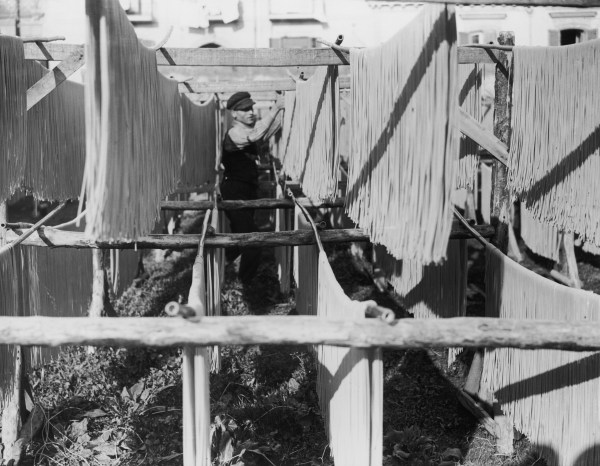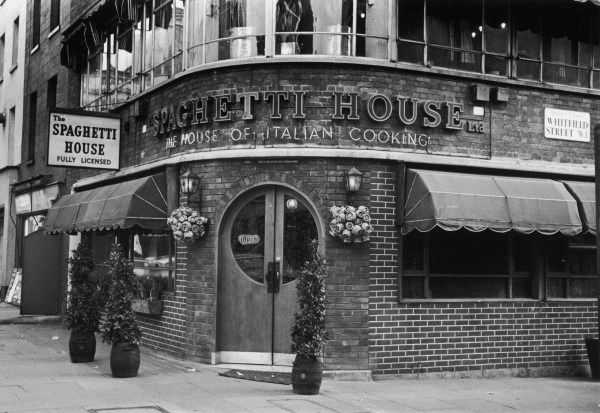My first culinary memory, the first time I realized that food could be deeply meaningful, is coming home from 3rd grade to find my dad making pasta from scratch in the kitchen. He was laughing and singing and there was fettuccine hanging everywhere. In the deepest recesses of my memory, I can envision seeing an after school special around that same time in which a kid comes home to find his dad with a strange woman. The boy is both crushed (for the obvious reasons) and shocked (because he realizes that his parents have whole lives he never knew about). The pasta moment between me and my dad was similar in that way, although far more innocent. My dad’s affair was with Italian food.
The pasta roller looked like something you might pick up at an estate sale. (Years later, my dad would buy a new one and cut a notch out of our kitchen table to make it mount-able; it was the closest my parents ever came to a divorce.) The pasta itself hung in long strands from a rack, which I’d always known as our clothes-drying rack, but was now serving its true purpose. On the stove, a red sauce bubbled — gravy, as you’ll often hear Italian-Americans call it, though my dad never used that term. It was blood-colored, thanks to copious glugs of red wine. Hopping onto the counter for a closer look, I saw a few bay leaves in the pot. My dad could make due without ingredients, he had the ability to improvise as a cook, but I never saw him make a red sauce without using bay leaf.
The day after I found my dad giddily making pasta, our extended family gathered for baked fettuccine with red sauce. The dish was covered in mozzarella, similar to the classic baked ziti or baked spaghetti recipes that you’ll find at first communion parties in outer Brooklyn. I remember liking it, though not as much as a liked Kraft Macaroni & Cheese. (Forgive me father, I was young.) But even if I didn’t get it at the time, I can still clearly picture the joy this feast brought to my uncles and aunts. Here again, it hit me: Food can mean something, and it can connect people.
I don’t think this is unique to my dad’s particular brand of East Coast immigrant community-influenced Italian food. Turn on any episode of Anthony Bourdain’s Parts Unknown and you’ll see him talking with locals from Iran to Australia about how food and alcohol build community. But I do think that the modern food movement sometimes strays from this sweet spot. In 2016, much of our food culture seems narcissistic. Every dish starts to feel like a chef looming over your shoulder, begging you to take a picture for Instagram or to tell everyone you know about the mushroom foam. The restaurant business is hard, so I very much get the desire to stand out through presentation and technique, and I often find myself liking that sort of food, but it can be redundant. We need variation.
That’s where the classic Italian restaurant comes in. It’s a major gear shift from the world of “so hot right now.” In fact, most old-school Italian food seems to fly directly in the face of every current food trend. Connection is still at the center of every experience.
Last week, Vince Mancini and I chatted about what defines the Italian restaurants we both love. Red and white checked table cloth isn’t mandatory. Some preparation of veal probably is. So are baked dishes like my dad’s fettuccine — bonus points if the place serves baked manicotti or cannelloni filled with sweet ricotta (double bonus if the ricotta is flecked with flat-leaf parsley). Unless you’re in landlocked city, spaghetti alle vongole ought to make an appearance. Also, the minestrone should have beans in it.
But what’s the point of me gushing about a certain type of cuisine or restaurant, just because I feel culturally tied to it?
Well, I guess I’m just not sure that we, the food obsessives, are really utilizing our options. Are we mixing high brow and low brow? Fine dining and street food? Old and new? Or are we just celebrating places with semi-random subject-ampersand-subject names? Whisk & Ladle. Pearl & Ash. Grain & Gristle. (All real, much-buzzed restaurants, by the way.)
A few weeks ago, Eddie Huang wrote an essay on Grubstreet in which he said, “A look at the photos of dining rooms on Eater’s 38 Essential New York Restaurants shows a collection of curated restaurants promoting the same aesthetic monoculture.” Later in the essay, he expands on this point when he writes:
…one of the things Eater has done is help push a kind of restaurant consensus around that monoculture, which goes a little like this: notable chef, must speak English, must be media-savvy, must have design-driven dining room, must kowtow to the scene, must have small plates, must push diverse histories through French ricers, must have toast points, must love dogs.
Huang was shoehorning some very valid opinions about food culture into an essay about the skinhead past of Eater’s Nick Solares. I don’t necessarily feel like the restaurant industry’s monoculture and the Solares situation are connected, but I do very much agree with Huang’s overarching point. Food-culture is homogenized in a whole bunch of ways. Too many star chefs are white, too much of the design and plating aesthetic is similar, and too many people are serving bacon with honey-glazed brussels sprouts or roast cauliflower. Also, from an alcohol standpoint, waaaaaaaaay too many bar programs are laser-focused on whiskey.
Bitters are awesome. Yes, I know what ‘shrub’ is. Can I please have a glass of wine poured from a fiasco bottle? Just this once?

Going to a classic Italian restaurant isn’t going to solve all of the issues that Huang raises, but it does hit a few of them. Here are some other perks, off the top of my head:
- The decor will be unapologetically gaudy — featuring plastic vines, peeling frescoes, and maybe even plaster columns. I love this. It’s insight into how a restaurant would have been designed to feel old-school, 35 years ago, back when the place was decorated. It’s like a historical diorama.
- The food will be excellent, but it won’t beg for attention. There’s a humility to old school Italian joints. The chef’s ego is never on display. Yes, the pasta is homemade; no, the menu doesn’t bother telling you. Yes, the food looks appetizing; no, it doesn’t invite you to pull out your phone. Yes, they leave too much of the stem on the parsley garnish; no, Food Network judges wouldn’t be pleased; no, it’s not as big of a deal as Scott Conant likes to pretend.
- The experience will make you nostalgic for an era you probably never lived in. We can thank mafia movies for this, and it’s not a bad thing. A good classic Italian place ought to feel like a scene from Goodfellas or The Godfather.
- Connection is the key. Big booths and circular tables abound.
- You will always have bread. This is a big deal.
I recently went to a place called Antonello’s Ristorante with my girlfriend. The waiters were from the old country, had pencil-thin mustaches, and took immense pride in their work. I have never felt so well attended to in my life. The chef was from an Italian village not far from Fano, where my grandfather owned a bakery. He and his food were the epitome of no nonsense. The dishes were fresh (the seafood came from the chef’s father, a fisherman), local, and prepared in-house, but no one had to drum that into my brain. I would never have known if I didn’t ask.
I think we had four baskets bread before we even ordered. After dinner, they brought out big slabs of spumoni ice cream. Again, it was made at the restaurant — with plump, syrupy Amarena cherries mixed in. But seeing that I was the youngest person eating there (and I’m 36) troubled me. It was a reminder that this type of restaurant is dying.
Obviously, I’m particularly protective of the food that represents my family’s Italian-immigrant ancestry, but lots of old-style ethnic restaurants are having a hard time staying profitable in what Huang calls our ‘monoculture.’ Ethiopian, Thai, Mexican, Chinese — if they don’t play the fusion/stylized/modern game, they get left behind. Reviewers don’t visit, buzz doesn’t get built, and sales suffer. Eventually, loyal diners die off and the restaurants go with them.
90% of restaurants close after a year. 70% of those close in the following three years. Even star chefs routinely shutter projects in favor of launching new ones. The value on having a #brand and getting love from the food-scene cool kids is higher than ever. Most times, I buy into this. I’ll wait in line at Egg Slut just like everyone else. But I do worry that we’re close to losing a very special type of food. I don’t mean Italian food (the hottest restaurant I know of right now is Italian). I mean old-feeling food. Served in old-feeling ways. At an old-feeling place. Where the customer is the star, rather than the chef.
What will be left when these restaurants close? A bunch of really cool spots that feel vaguely similar and The Olive Garden — a chain that successfully capitalizes on all the kitschy things I love about classic Italian restaurants, without being nearly as good. But at least they serve unlimited bread there, because I might have to take what I can get. Progress marches on, the world changes, and the older things that we love slowly disappear. Time stalks us all, I suppose, and we can’t stop it.
Which is a little bleak, since we’re just talking about manicotti and cannelloni. I might be seeing this as a bigger deal than it is, considering that my father, the great pasta roller, died two years ago and took a lot of his old recipes with him. All I really wanted to say is that you should track down the oldest Italian joint in your city and make a reservation. Before it’s too late.







